Hyundai Azera 2005 Owner's Manual
Manufacturer: HYUNDAI, Model Year: 2005, Model line: Azera, Model: Hyundai Azera 2005Pages: 297, PDF Size: 13.2 MB
Page 251 of 297
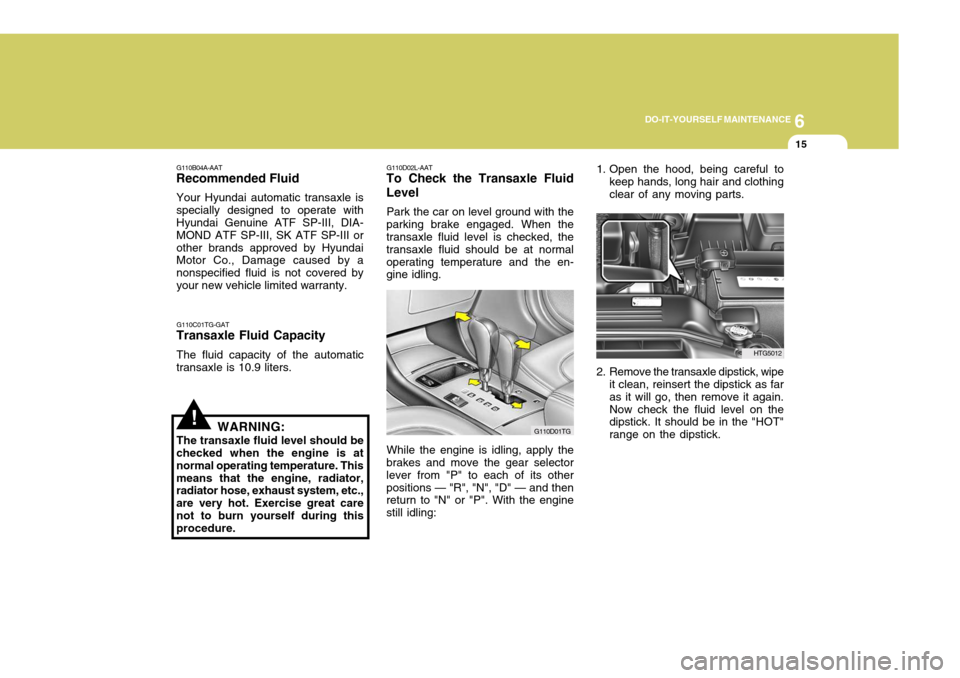
6
DO-IT-YOURSELF MAINTENANCE
15
!
1. Open the hood, being careful to
keep hands, long hair and clothing clear of any moving parts.
2. Remove the transaxle dipstick, wipe it clean, reinsert the dipstick as faras it will go, then remove it again.Now check the fluid level on the dipstick. It should be in the "HOT" range on the dipstick. HTG5012
G110C01TG-GAT
Transaxle Fluid Capacity
The fluid capacity of the automatic
transaxle is 10.9 liters.
WARNING:
The transaxle fluid level should be
checked when the engine is atnormal operating temperature. Thismeans that the engine, radiator, radiator hose, exhaust system, etc., are very hot. Exercise great carenot to burn yourself during this procedure. G110D02L-AAT
To Check the Transaxle Fluid Level
Park the car on level ground with the
parking brake engaged. When the transaxle fluid level is checked, the transaxle fluid should be at normaloperating temperature and the en- gine idling.
While the engine is idling, apply the
brakes and move the gear selector lever from "P" to each of its otherpositions — "R", "N", "D" — and then return to "N" or "P". With the engine still idling:
G110D01TG
G110B04A-AAT
Recommended Fluid
Your Hyundai automatic transaxle is specially designed to operate with Hyundai Genuine ATF SP-III, DIA- MOND ATF SP-III, SK ATF SP-III orother brands approved by Hyundai Motor Co., Damage caused by a nonspecified fluid is not covered byyour new vehicle limited warranty.
Page 252 of 297
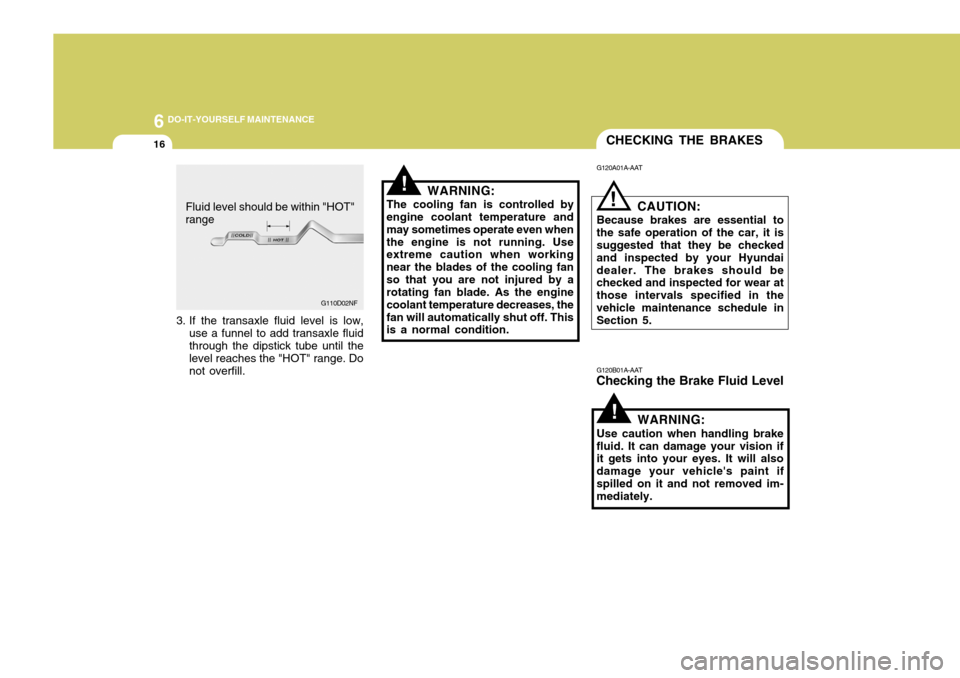
6 DO-IT-YOURSELF MAINTENANCE
16
!
!
G110D02NF
Fluid level should be within "HOT"
range WARNING:
The cooling fan is controlled by engine coolant temperature and may sometimes operate even whenthe engine is not running. Use extreme caution when working near the blades of the cooling fanso that you are not injured by a rotating fan blade. As the engine coolant temperature decreases, thefan will automatically shut off. This is a normal condition.
3. If the transaxle fluid level is low,
use a funnel to add transaxle fluid through the dipstick tube until the level reaches the "HOT" range. Do not overfill.
CHECKING THE BRAKES
G120A01A-AAT G120B01A-AAT
Checking the Brake Fluid Level
! CAUTION:
Because brakes are essential to the safe operation of the car, it is suggested that they be checked and inspected by your Hyundaidealer. The brakes should be checked and inspected for wear at those intervals specified in thevehicle maintenance schedule in Section 5.
WARNING:
Use caution when handling brake fluid. It can damage your vision if it gets into your eyes. It will also damage your vehicle's paint ifspilled on it and not removed im- mediately.
Page 253 of 297
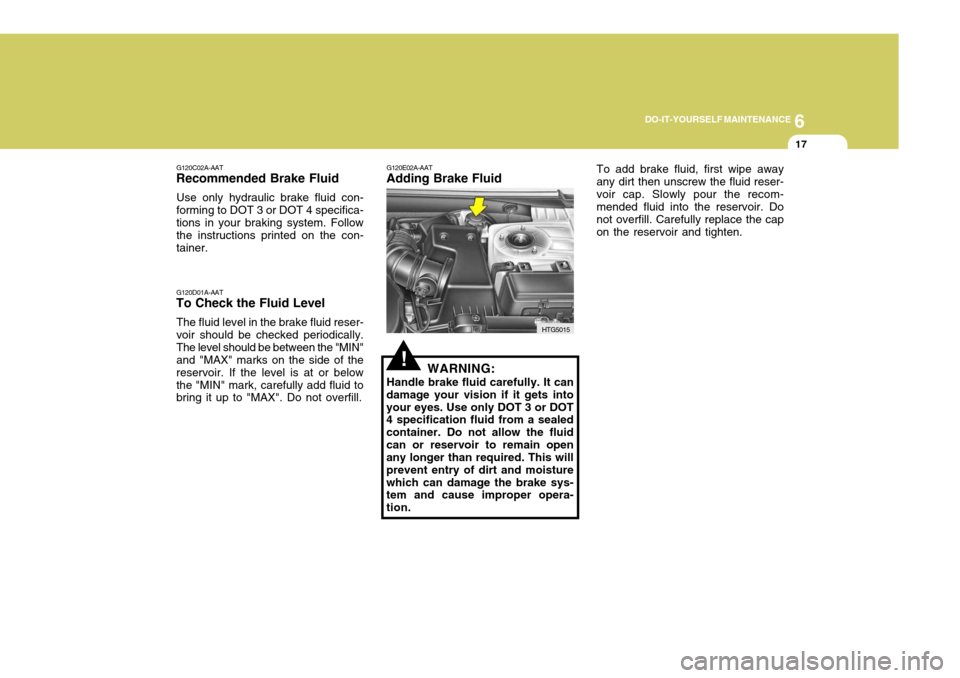
6
DO-IT-YOURSELF MAINTENANCE
17
!
To add brake fluid, first wipe away any dirt then unscrew the fluid reser-voir cap. Slowly pour the recom- mended fluid into the reservoir. Do not overfill. Carefully replace the capon the reservoir and tighten.G120E02A-AAT
Adding Brake Fluid
WARNING:
Handle brake fluid carefully. It can
damage your vision if it gets into your eyes. Use only DOT 3 or DOT 4 specification fluid from a sealed container. Do not allow the fluidcan or reservoir to remain open any longer than required. This will prevent entry of dirt and moisturewhich can damage the brake sys- tem and cause improper opera- tion. HTG5015
G120C02A-AAT
Recommended Brake Fluid
Use only hydraulic brake fluid con-forming to DOT 3 or DOT 4 specifica- tions in your braking system. Follow the instructions printed on the con-tainer. G120D01A-AAT
To Check the Fluid Level
The fluid level in the brake fluid reser- voir should be checked periodically.The level should be between the "MIN" and "MAX" marks on the side of the reservoir. If the level is at or belowthe "MIN" mark, carefully add fluid to bring it up to "MAX". Do not overfill.
Page 254 of 297
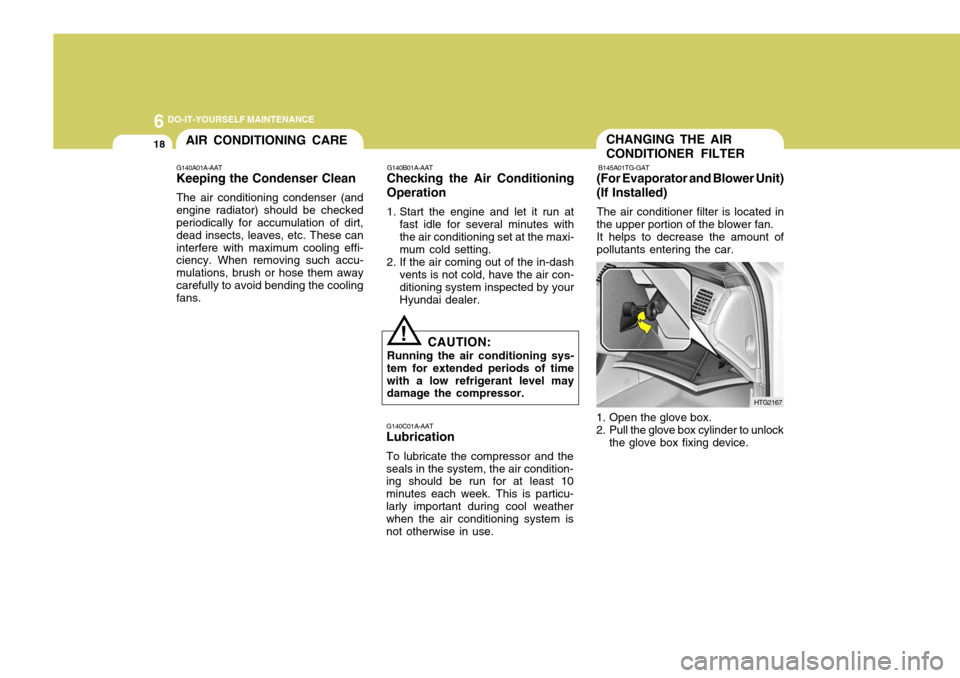
6 DO-IT-YOURSELF MAINTENANCE
18
G140C01A-AAT
Lubrication
To lubricate the compressor and the
seals in the system, the air condition- ing should be run for at least 10 minutes each week. This is particu-larly important during cool weather when the air conditioning system is not otherwise in use.CHANGING THE AIR CONDITIONER FILTER
B145A01TG-GAT
(For Evaporator and Blower Unit)(If Installed)
The air conditioner filter is located in
the upper portion of the blower fan. It helps to decrease the amount of
pollutants entering the car.
1. Open the glove box.
2. Pull the glove box cylinder to unlock the glove box fixing device. HTG2167
G140B01A-AAT
Checking the Air Conditioning Operation
1. Start the engine and let it run at
fast idle for several minutes with the air conditioning set at the maxi- mum cold setting.
2. If the air coming out of the in-dash vents is not cold, have the air con-ditioning system inspected by yourHyundai dealer.
CAUTION:
Running the air conditioning sys-
tem for extended periods of timewith a low refrigerant level may damage the compressor.
!
AIR CONDITIONING CARE
G140A01A-AAT Keeping the Condenser Clean The air conditioning condenser (and engine radiator) should be checked periodically for accumulation of dirt, dead insects, leaves, etc. These caninterfere with maximum cooling effi- ciency. When removing such accu- mulations, brush or hose them awaycarefully to avoid bending the cooling fans.
Page 255 of 297
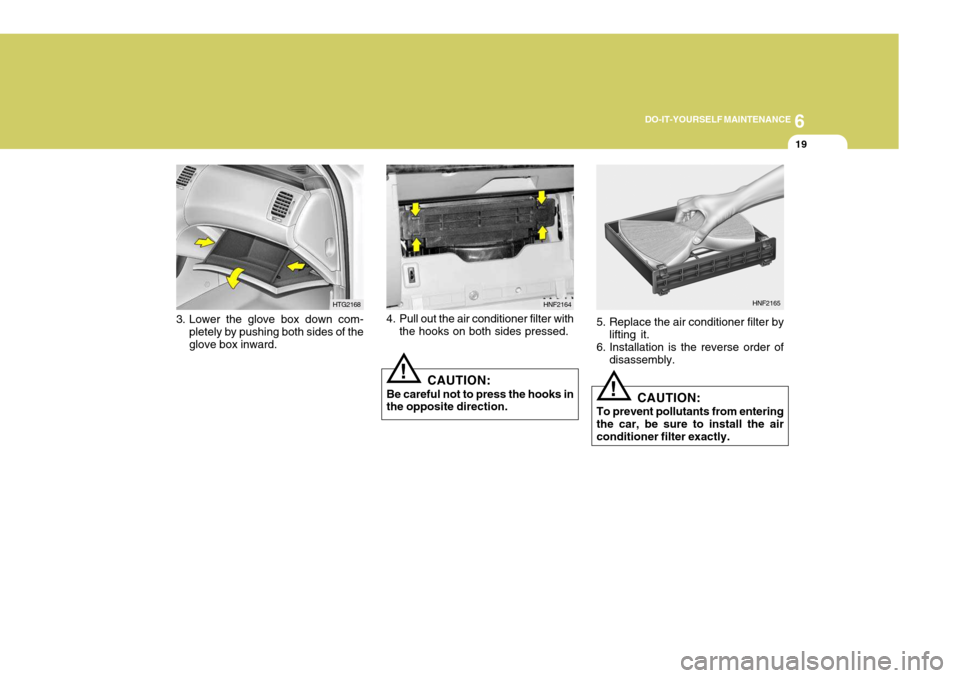
6
DO-IT-YOURSELF MAINTENANCE
19
3. Lower the glove box down com-
pletely by pushing both sides of the glove box inward. HTG21684. Pull out the air conditioner filter with
the hooks on both sides pressed. HNF2164
HNF2165
!
CAUTION:
Be careful not to press the hooks in the opposite direction. 5. Replace the air conditioner filter by
lifting it.
6. Installation is the reverse order of
disassembly.
CAUTION:
To prevent pollutants from entering the car, be sure to install the airconditioner filter exactly.
!
Page 256 of 297
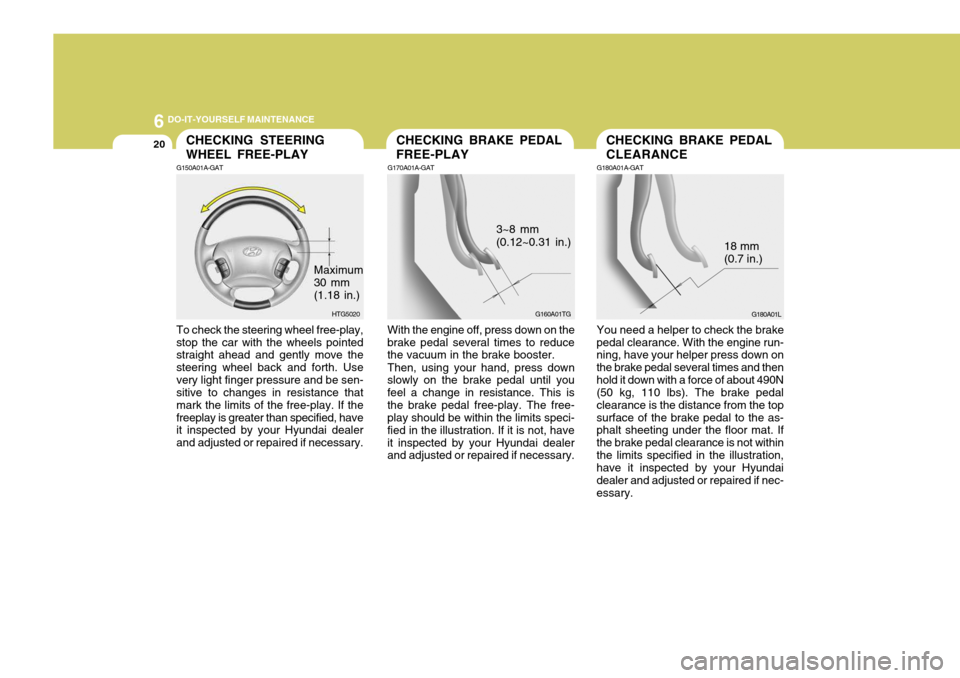
6 DO-IT-YOURSELF MAINTENANCE
20
G180A01L
18 mm (0.7 in.)
You need a helper to check the brake
pedal clearance. With the engine run- ning, have your helper press down on the brake pedal several times and thenhold it down with a force of about 490N (50 kg, 110 lbs). The brake pedal clearance is the distance from the topsurface of the brake pedal to the as- phalt sheeting under the floor mat. If the brake pedal clearance is not withinthe limits specified in the illustration, have it inspected by your Hyundai dealer and adjusted or repaired if nec-essary.
With the engine off, press down on the
brake pedal several times to reduce the vacuum in the brake booster.
Then, using your hand, press down
slowly on the brake pedal until you feel a change in resistance. This isthe brake pedal free-play. The free- play should be within the limits speci- fied in the illustration. If it is not, haveit inspected by your Hyundai dealer and adjusted or repaired if necessary. G160A01TG
3~8 mm (0.12~0.31 in.)To check the steering wheel free-play, stop the car with the wheels pointed straight ahead and gently move the steering wheel back and forth. Usevery light finger pressure and be sen- sitive to changes in resistance that mark the limits of the free-play. If thefreeplay is greater than specified, have it inspected by your Hyundai dealer and adjusted or repaired if necessary. HTG5020
Maximum 30 mm (1.18 in.)
CHECKING STEERING WHEEL FREE-PLAY
G150A01A-GATCHECKING BRAKE PEDAL FREE-PLAY
G170A01A-GATCHECKING BRAKE PEDAL CLEARANCE
G180A01A-GAT
Page 257 of 297
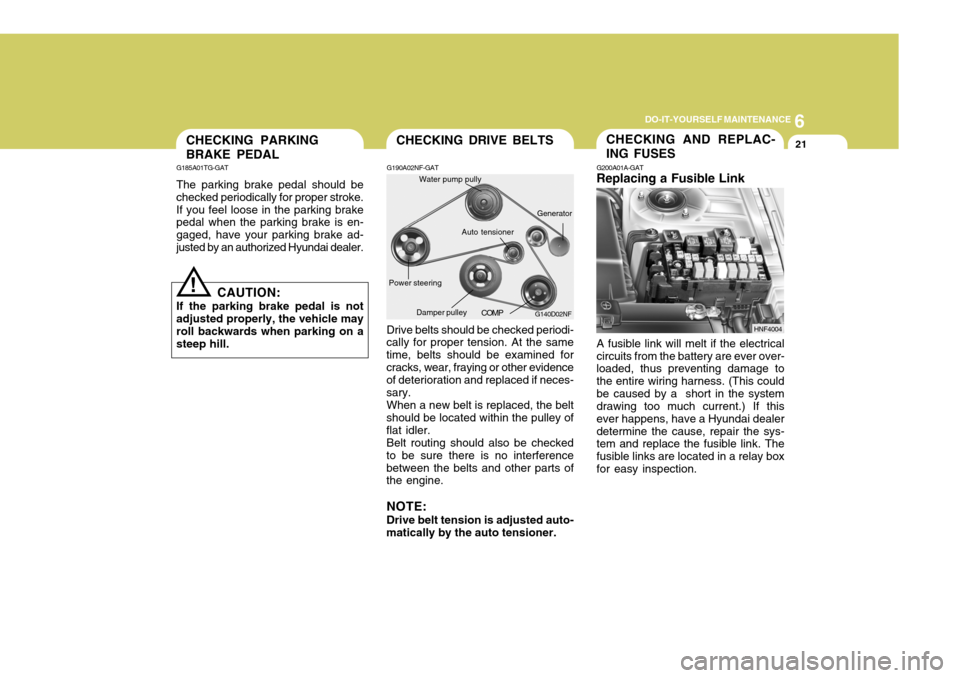
6
DO-IT-YOURSELF MAINTENANCE
21
G190A02NF-GAT
Drive belts should be checked periodi-
cally for proper tension. At the same time, belts should be examined forcracks, wear, fraying or other evidence of deterioration and replaced if neces- sary.
When a new belt is replaced, the belt
should be located within the pulley offlat idler. Belt routing should also be checked
to be sure there is no interferencebetween the belts and other parts of the engine.
NOTE: Drive belt tension is adjusted auto-
matically by the auto tensioner. CHECKING DRIVE BELTS
G140D02NF
Power steeringCOMP
Water pump pully
Generator
Damper pulley
Auto tensioner
CHECKING AND REPLAC- ING FUSES
G200A01A-GAT
Replacing a Fusible Link
A fusible link will melt if the electrical circuits from the battery are ever over- loaded, thus preventing damage to the entire wiring harness. (This couldbe caused by a short in the system drawing too much current.) If this ever happens, have a Hyundai dealerdetermine the cause, repair the sys- tem and replace the fusible link. The fusible links are located in a relay boxfor easy inspection. HNF4004
The parking brake pedal should bechecked periodically for proper stroke.If you feel loose in the parking brake pedal when the parking brake is en- gaged, have your parking brake ad-justed by an authorized Hyundai dealer.CHECKING PARKING BRAKE PEDAL
G185A01TG-GAT
CAUTION:
If the parking brake pedal is not adjusted properly, the vehicle may roll backwards when parking on a steep hill.
!
Page 258 of 297
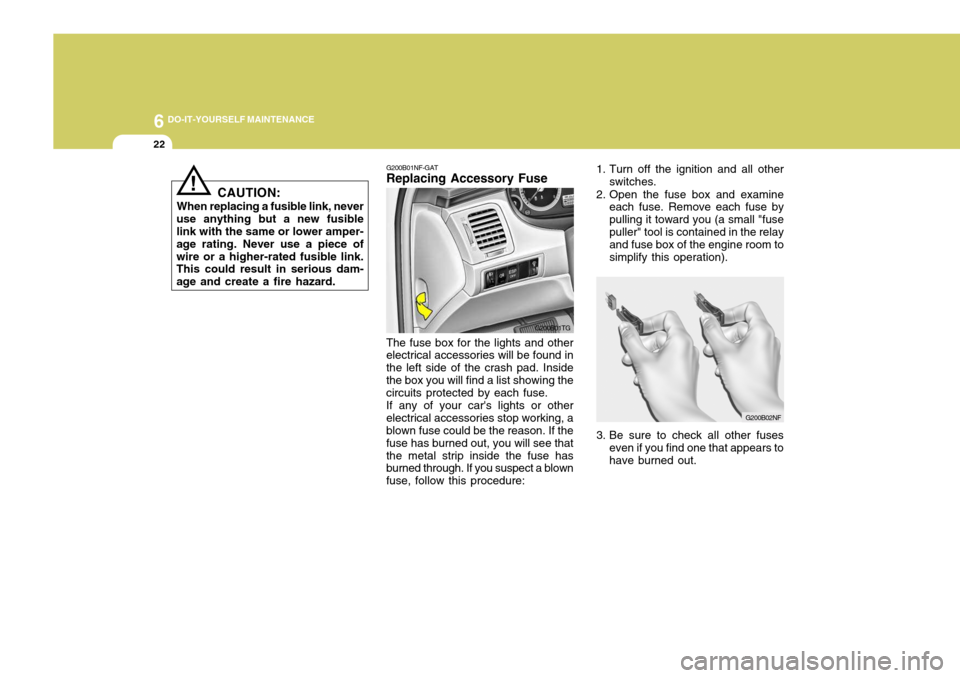
6 DO-IT-YOURSELF MAINTENANCE
22
1. Turn off the ignition and all other
switches.
2. Open the fuse box and examine each fuse. Remove each fuse by pulling it toward you (a small "fusepuller" tool is contained in the relay and fuse box of the engine room to simplify this operation).
G200B02NF
3. Be sure to check all other fuses even if you find one that appears tohave burned out.G200B01NF-GAT Replacing Accessory Fuse
G200B01TG
The fuse box for the lights and other electrical accessories will be found in the left side of the crash pad. Insidethe box you will find a list showing the circuits protected by each fuse. If any of your car's lights or other electrical accessories stop working, a blown fuse could be the reason. If the fuse has burned out, you will see thatthe metal strip inside the fuse has burned through. If you suspect a blown fuse, follow this procedure:
CAUTION:
When replacing a fusible link, never
use anything but a new fusible link with the same or lower amper- age rating. Never use a piece ofwire or a higher-rated fusible link. This could result in serious dam- age and create a fire hazard.
!
Page 259 of 297
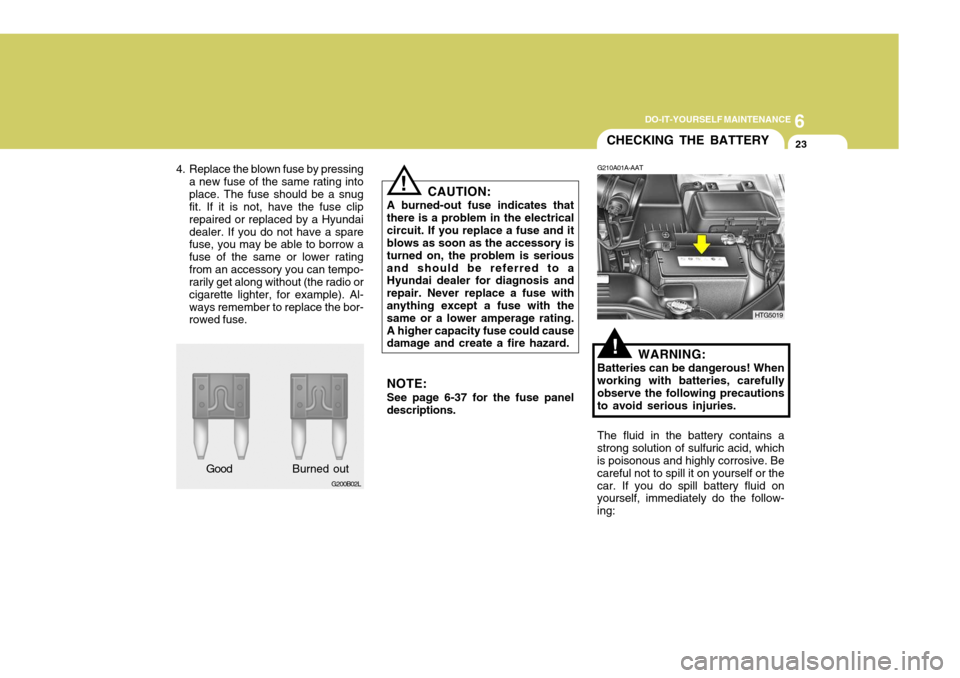
6
DO-IT-YOURSELF MAINTENANCE
23
CAUTION:
A burned-out fuse indicates that there is a problem in the electricalcircuit. If you replace a fuse and it blows as soon as the accessory is turned on, the problem is seriousand should be referred to a Hyundai dealer for diagnosis and repair. Never replace a fuse withanything except a fuse with the same or a lower amperage rating. A higher capacity fuse could cause damage and create a fire hazard. NOTE: See page 6-37 for the fuse panel descriptions.
!
CHECKING THE BATTERY
G210A01A-AAT
WARNING:
Batteries can be dangerous! When working with batteries, carefully observe the following precautionsto avoid serious injuries. The fluid in the battery contains a
strong solution of sulfuric acid, which is poisonous and highly corrosive. Be careful not to spill it on yourself or thecar. If you do spill battery fluid on yourself, immediately do the follow- ing: HTG5019
!
4. Replace the blown fuse by pressing
a new fuse of the same rating into place. The fuse should be a snug fit. If it is not, have the fuse clip repaired or replaced by a Hyundaidealer. If you do not have a spare fuse, you may be able to borrow a fuse of the same or lower ratingfrom an accessory you can tempo- rarily get along without (the radio or cigarette lighter, for example). Al-ways remember to replace the bor- rowed fuse.
G200B02L
Good B
urned out
Page 260 of 297
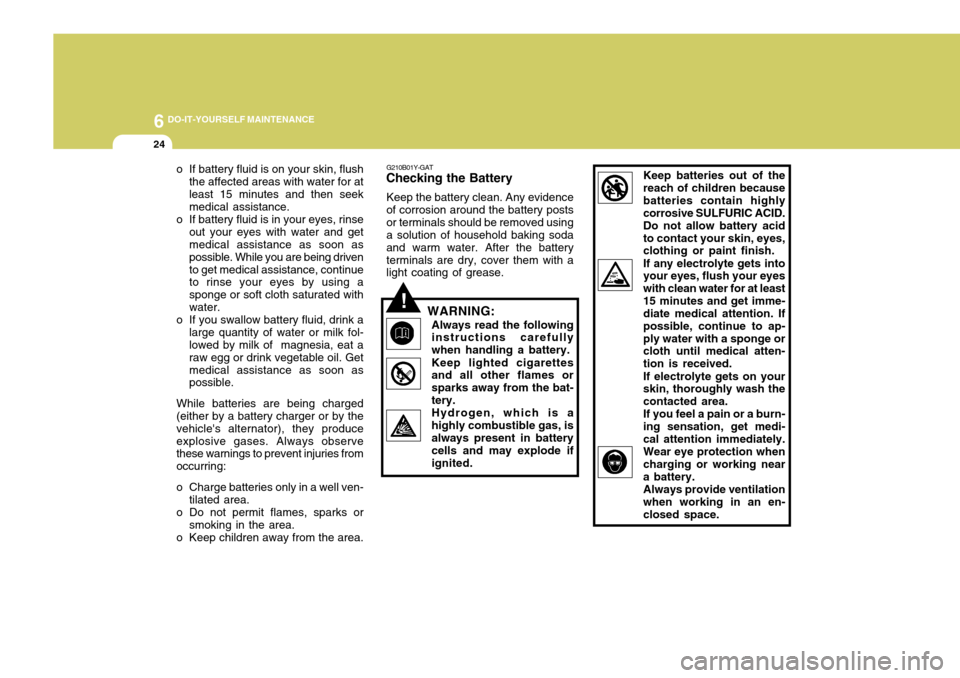
6 DO-IT-YOURSELF MAINTENANCE
24
Keep batteries out of the reach of children becausebatteries contain highly corrosive SULFURIC ACID. Do not allow battery acidto contact your skin, eyes, clothing or paint finish. If any electrolyte gets into your eyes, flush your eyes with clean water for at least15 minutes and get imme- diate medical attention. If possible, continue to ap-ply water with a sponge or cloth until medical atten- tion is received. If electrolyte gets on your skin, thoroughly wash the contacted area.If you feel a pain or a burn-ing sensation, get medi-cal attention immediately.Wear eye protection whencharging or working neara battery.Always provide ventilationwhen working in an en- closed space.
!
G210B01Y-GAT
Checking the Battery
Keep the battery clean. Any evidence of corrosion around the battery postsor terminals should be removed using a solution of household baking soda and warm water. After the batteryterminals are dry, cover them with a light coating of grease.
WARNING:Always read the followinginstructions carefully when handling a battery. Keep lighted cigarettes and all other flames or sparks away from the bat-tery.Hydrogen, which is ahighly combustible gas, is always present in battery cells and may explode ifignited.o If battery fluid is on your skin, flush the affected areas with water for at least 15 minutes and then seek medical assistance.
o If battery fluid is in your eyes, rinse out your eyes with water and getmedical assistance as soon as possible. While you are being drivento get medical assistance, continue to rinse your eyes by using a sponge or soft cloth saturated withwater.
o If you swallow battery fluid, drink a large quantity of water or milk fol- lowed by milk of magnesia, eat a raw egg or drink vegetable oil. Getmedical assistance as soon as possible.
While batteries are being charged(either by a battery charger or by the vehicle's alternator), they produceexplosive gases. Always observe these warnings to prevent injuries from occurring:
o Charge batteries only in a well ven- tilated area.
o Do not permit flames, sparks or smoking in the area.
o Keep children away from the area.